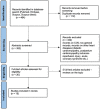Crosstalk between microRNA and Oxidative Stress in Heart Failure: A Systematic Review
- PMID: 36499336
- PMCID: PMC9736401
- DOI: 10.3390/ijms232315013
Crosstalk between microRNA and Oxidative Stress in Heart Failure: A Systematic Review
Abstract
Heart failure is defined as a clinical syndrome consisting of key symptoms and is due to a structural and/or functional alteration of the heart that results in increased intracardiac pressures and/or inadequate cardiac output at rest and/or during exercise. One of the key mechanisms determining myocardial dysfunction in heart failure is oxidative stress. MicroRNAs (miRNAs, miRs) are short, endogenous, conserved, single-stranded non-coding RNAs of around 21-25 nucleotides in length that act as regulators of multiple processes. A systematic review following the PRISMA guidelines was performed on the evidence on the interplay between microRNA and oxidative stress in heart failure. A search of Pubmed, Embase, Scopus, and Scopus direct databases using the following search terms: 'heart failure' AND 'oxidative stress' AND 'microRNA' or 'heart failure' AND 'oxidative stress' AND 'miRNA' was conducted and resulted in 464 articles. Out of them, 15 full text articles were eligible for inclusion in the qualitative analysis. Multiple microRNAs are involved in the processes associated with oxidative stress leading to heart failure development including mitochondrial integrity and function, antioxidant defense, iron overload, ferroptosis, and survival pathways.
Keywords: ROS; heart failure; microRNA; mitochondria; myocardial hypertrophy; myocardial remodeling; oxidative stress.
Conflict of interest statement
The authors declare no conflict of interest.
Figures
References
Publication types
MeSH terms
Substances
LinkOut - more resources
Full Text Sources
Medical



